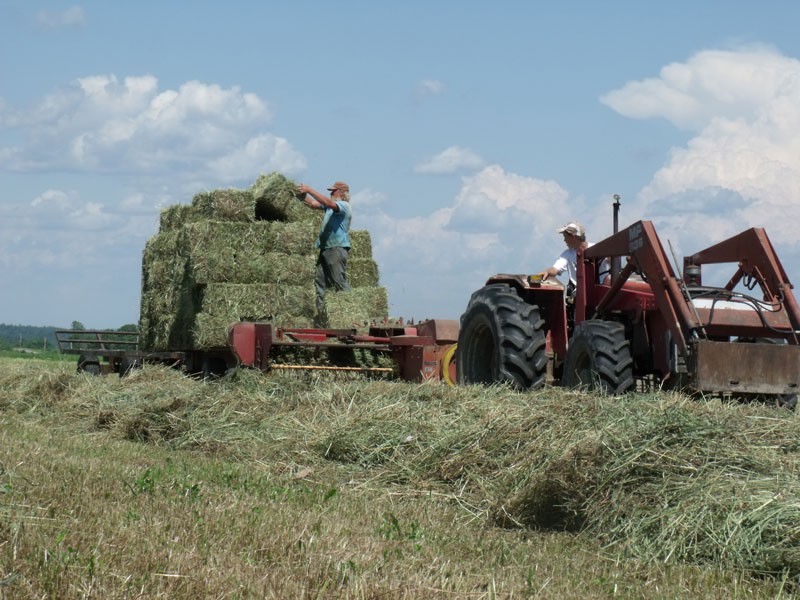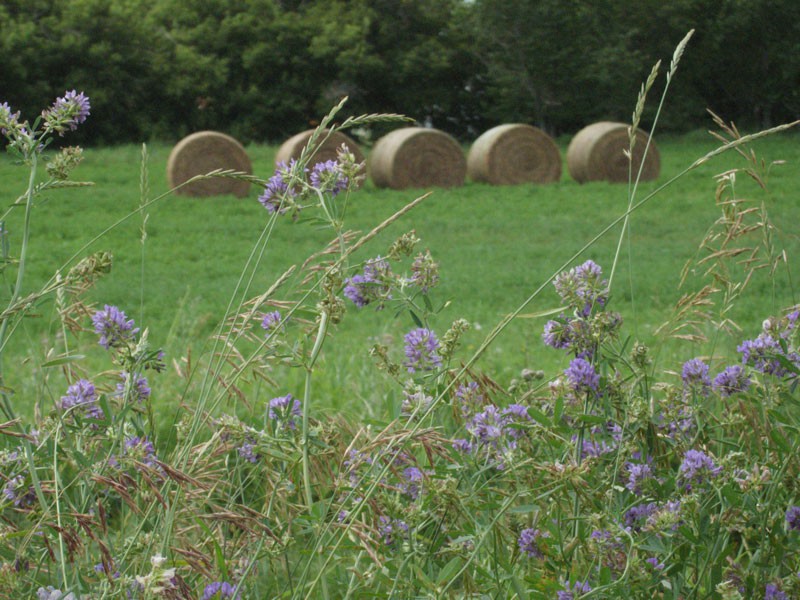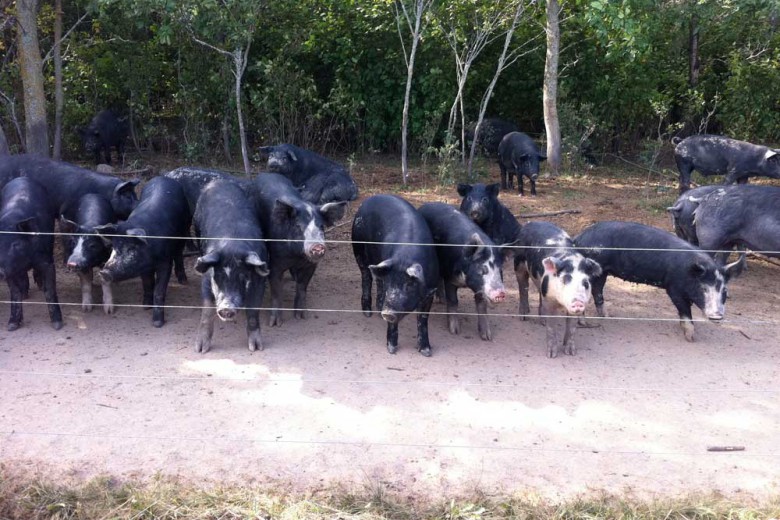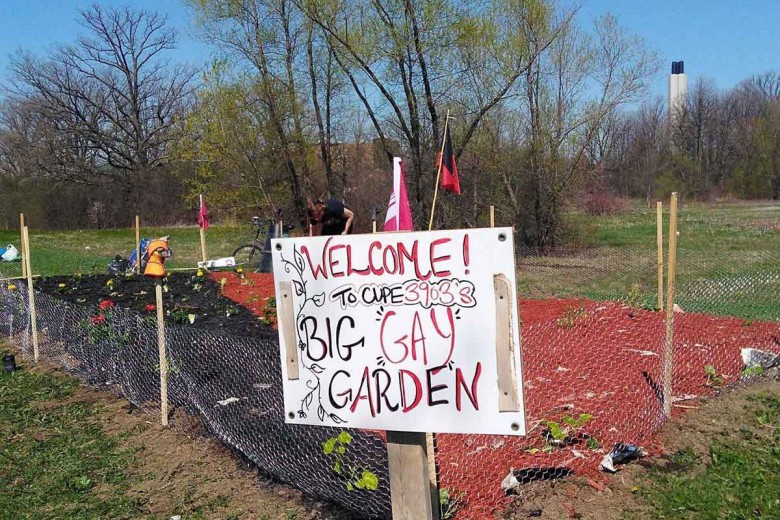
You might have missed it, but this spring thousands of people across Canada came out to 38 rallies organized by farmers and their supporters. In addition to these April 9 rallies, people inundated their MPs with letters and petitions, emailed, made phone calls, and asked for meetings. They were responding to a call from the National Farmers Union – Ontario for a day of action against the release of genetically modified (GM) alfalfa in Canada.
Why all the fuss about a crop that most city people have barely heard of except as a sandwich option? Alfalfa is grown on over 10 million hectares, almost 30 per cent of Canada’s farmland, and used in more ways than perhaps any other crop. It is a nutritious, high-protein, perennial forage crop used to feed livestock, especially dairy cows, both on pasture and as hay. It improves soil fertility because its roots host a bacteria that grabs nitrogen from the atmosphere and converts it for plant absorption. This nitrogen-fixing property is especially important for organic farmers who cannot use chemical fertilizers.
When farmers include alfalfa in their crop rotation, it builds organic matter, sequestering carbon and making the soil both more flood tolerant and drought resistant. Alfalfa also grows into a thick, bushy plant which crowds other plants, so farmers can use it to clean up a weedy field. Alfalfa blooms prolifically, and its flowers are a good source of nectar for pollinators, including domestic honeybees. Special leafcutter bees are used to ensure high rates of pollination when alfalfa is grown for seed, which is sold to farmers for planting or to the sandwich trade for sprouting.
Enter Monsanto
Monsanto has genetically engineered the Roundup Ready trait into alfalfa and, through its licensee Forage Genetics International (FGI), wants to sell it in Canada. The genetic modification makes it possible for alfalfa to survive Monsanto’s glyphosate herbicide, Roundup, which kills all other plants.
Roundup Ready alfalfa (RRA) was approved by Health Canada and the Canadian Food Inspection Agency (CFIA) in 2005, but due to delays in commercializing it in the U.S., Monsanto only recently started its push to sell it in Canada. The last administrative hurdle it had to clear was registration of a GM seed variety.
Farmers oppose commercial release of genetically modified alfalfa because they know that it will quickly cross-pollinate and contaminate non-GM alfalfa. The use of RRA will increase the use of glyphosate, hastening the development of herbicide-resistant weeds, which are already a problem. Those farmers who use Roundup Ready soybeans, corn, and canola would not be able to kill volunteer RRA plants when they spray glyphosate for weed control and would have to either use additional herbicides to kill them or leave them to mature (and bloom, spreading pollen) while their crops ripen.
Beekeepers are concerned about losing markets for alfalfa honey. Organic farmers are worried about being unable to use alfalfa in their crop rotation or to feed it to their livestock due to the extremely high probability of contamination (contravening organic certification). Farmers who export alfalfa to sensitive markets such as Japan and Europe risk losing their customers.
Above all, farmers are opposed to RRA because there is no need for herbicide-resistant alfalfa. Hay is normally grown as a mixture of grasses and alfalfa, balancing roughage and protein to provide an optimum diet for cattle. Spraying it would kill the grasses. Alfalfa is highly weed-competitive in its second and later years. It’s usually planted with a cover crop which is harvested and sold the first year when the alfalfa seedlings are getting established. Spraying is unnecessary.
What is Roundup Ready Alfalfa?
Roundup Ready Alfalfa (RRA) contains a gene sequence that enables it to continue producing a critical enzyme, EPSPS, in spite of being sprayed with glyphosate that destroys the EPSPS pathway in other plants. The engineered gene sequence is made from a combination of bacterial and plant genomes and a virus genome.
The gene sequence was inserted into alfalfa cells using Agrobacterium tumefaciens, a parasitic bacteria that invades plants by inserting its own DNA into the plant’s chromosomes. Monsanto employed this bacteria to insert plasmids (loops of DNA) with the above gene sequence into alfalfa tissue. Tissue that survived treatment with glyphosate was introduced to whole plants via a tissue culture process. These plants were then bred to produce seed.
“It’s another case of the big companies trying to sell us something we don’t need,” says Tim Tabbert, a farmer in Renfrew County, Ont.
Farmers also know that Monsanto claims patent rights on Roundup Ready genes. As a result of the 2004 Supreme Court Schmeiser decision, it doesn’t matter how a plant with a patented gene got into a field or whether the farmer intends to take advantage of the trait: the company has the right to claim for patent infringement. If RRA is introduced, farmers who want to grow alfalfa will not only risk damage to their markets from contamination, they also risk having Monsanto sue them.
Ian Robson, who runs a mixed farm in Manitoba, says, “It could become like canola where you have nothing but the choice of a Roundup GM alfalfa. Then you are stuck. I mean, you’re like an addict. You have to go every year and pay money for this new seed.”
As a result of the public attention on April 9, Monsanto’s licensee FGI admitted that it has applied to have one variety of RRA registered but said it wouldn’t start selling RRA this spring. Barely two weeks after the April 9 day of action – a clear statement of public opposition – the CFIA registered FGI’s RRA variety. According to the CFIA website, the seed will be imported by Gold Medal Seeds Inc., a subsidiary of FGI, and distributed in Ontario by GrowMark and in Quebec by Synagri, a subsidiary of Cargill.
FGI is a subsidiary of Land o’ Lakes, a large U.S. co-operative, and GrowMark is a network of U.S. and Ontario-based agricultural supply co-ops. These “co-ops” must have shredded their last copy of the co-op principles, as principle #7, Concern for Community, should have eliminated RRA from their business plan.
Public pressure on the companies continues. Now Monsanto says it is up to FGI to decide whether and when to begin selling in Canada. FGI says it won’t sell it until there is a “coexistence plan” in place. “Coexistence” is a public relations term the biotech industry uses to pretend it’s possible to control genetic material contained in living plants that have reproduction as their biological imperative.

Enter the Canadian Seed Trade Association (CSTA), a lobby group whose board of directors includes Monsanto’s marketing manager. The CSTA has created a coexistence plan on behalf of Monsanto in an attempt to deflect opposition to RRA. It virtually dismisses bees, livestock, wild animals, birds, and untended wild (feral) and volunteer alfalfa plants as vectors for pollen and seed dispersal. The plan has no enforcement mechanism, is under no authority’s jurisdiction, depends on farmers doing extra work without compensation, and requires eternal vigilance by all involved in alfalfa production, transport, and sales.
Farmers don’t buy it.
“The CSTA’s claim that it can prevent GM alfalfa from contaminating non-GM alfalfa crops is utterly absurd,” says Phil Woodhouse of Grey County, Ont. “Make no mistake – GM alfalfa will cross-pollinate with non-GM and organic alfalfa and will threaten the very livelihood of Ontario’s family farmer.”
“The prospect of having genetically modified alfalfa that is not going to be distinguishable in any way, shape, or form from conventional varieties frightens me,” says Cory Ollikka, who farms north of Edmonton. “We’ve seen what happened with canola, and those products are basically impossible to grow on an organic basis any longer because of the proliferation of GM varieties in the seed supply.”
Only a tiny minority of farmers that want to grow pure stands of alfalfa would have any interest in the product. Their short-term – and perhaps uninformed – interest should be outweighed by the vast majority of farmers who stand to lose not only money but, for organic farmers, a valuable agronomic tool.
Why have things gotten this far? Canada’s regulatory system is sadly lacking – or else designed to fail Canadians. The CFIA does not consider market harm or any other social, economic, or broad ecological impacts when approving genetically modified organisms (which it calls plants with novel traits). The variety registration system does not consider market impacts. “Do not enter” is the message to citizens: there is no public process for farmers to intervene in decision-making regarding GM crops.

The CFIA’s door may be closed, but farmers have not given up. On July 25 two Ontario farmers, with the support of the Organic Agriculture Protection Fund, the National Farmers Union, and the Canadian Biotechnology Action Network, opened another door. They have formally requested under Ontario’s Environmental Bill of Rights that the province require a full environmental assessment of RRA – including social, economic, and ecological impacts – before any seed can be sold there.
Eastern Canada is the target market, so stopping it there will protect the rest of Canada. The application details the problems of RRA, the complete inadequacy of any coexistence strategy, and the need for better oversight than what the federal regulatory process currently provides. If Ontario agrees to the full environmental assessment, it will set an important precedent.
Just like the successful fight to stop GM wheat in the early 2000s, farmers and non-farm allies are working together. Without a strong, loud, and persistent public voice, the biotech industry will keep rolling forward in its aggressive pursuit of profit and control.
Citizen action has stopped the introduction of GM flax, wheat, and pigs. People have pressured companies to remove GM potatoes and tomatoes from the market. We stopped BST, the genetically engineered cow hormone, from being used on cows in Canada. Efforts to get GM apples and salmon have stalled. Let’s add GM alfalfa to this list of victories.
Help stop GM alfalfa and DONATE NOW.
Learn more at the Canadian Biotechnology Action Network.






